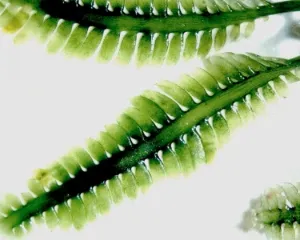5 Invasive Species You Should Know

Regardless of what continent you live on, the waters that surround it are home to marine invaders. The ocean is teeming with plants and animals willing and able to move beyond their native habitats. Often all they need is a ride. Enter: humans. Some invaders hitchhike on ship hulls or inside ballast tanks, others are introduced through the aquarium trade. However they move, invasive species can alter ecosystems, food webs, and economies. The Smithsonian Environmental Research Center’s Marine Invasions Lab travels the globe to better understand the movement and impacts of invasive species. We asked them to introduce us to five marine invaders.
1. Green Crab (Carcinus maenas)
This European crab has been carried by ships in ballast water and is sold as fish bait in much of the world. It now has established populations on both coasts of North America, in southern South America, Australia, South Africa, and Japan. It is a predator of many forms of shore life, including worms and mollusks. In some areas, the crab’s voracious appetite has affected the commercial shellfish industry.
2. Killer Algae (Caulerpa taxifolia)
A strain of this green seaweed, native to the Indian and Pacific Oceans, has escaped public and private aquariums in California, Japan, Australia, and Monaco. It has spread widely in the Mediterranean, replacing native plants and depriving marine life of food and habitat. In California, it was eradicated at considerable cost using toxic chemicals.
3. Sea Walnut (Mnemiopsis leidyi)
This ctenophore (a stingless jellyfish-like animal) is native to the east coast of North and South America. In 1982, it was discovered in the Black Sea, where it was transported by ballast water. It subsequently spread to the Caspian Sea. In both places, it multiplied and formed immense populations. The sea walnuts contributed to the collapse of local fisheries because they feed on zooplankton that the commercial fish also consume. Mnemiopsis leidy has also been discovered in the Mediterranean, Baltic, and North Seas.
4. Veined Rapa Whelk (Rapana venosa)
A large marine snail with a beautiful shell, Rapana venosa is native to the northwest Pacific, from Vladivostok, Russia to Hong Kong. In 1946 it was discovered in the Black Sea and later spread to the Mediterranean Sea. In 1998, it was found in the Chesapeake Bay where it was probably transported in the ballast water of ships. It is also established in European coastal waters from Norway to Spain, and in the Rio de la Plata estuary in South America. This animal, a predator on bivalve mollusks, severely reduced shellfish in the Black Sea, but is now fished and sold to Asian countries as food. Its role as a predator in the Chesapeake Bay is being studied, and it is expected to colonize other parts of the east coast.
5. Zebra Mussel (Dreissena polymorpha)
This bivalve mollusk is native to the Caspian Sea, lagoons of the Black Sea and their inflowing rivers. It lives in fresh and brackish water and cannot tolerate full seawater. In the 18th and 19th centuries, it spread through European canals, reaching the Baltic Sea and many European river estuaries. In 1998, it was discovered in the Great Lakes and has since spread to many rivers and lakes in eastern and central North America. The mollusk has fouled power plants, water purification facilities, ships, and littered beaches with decaying mussels and sharp shells. Large populations have devoured plankton and decreased the food available for commercial and game fish. It is abundant in the fresh, tidal parts of the St. Lawrence and Hudson Rivers, and has been discovered at the head of Chesapeake Bay.






